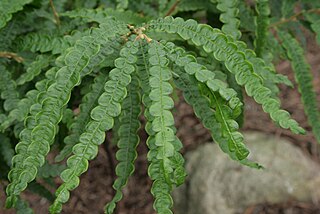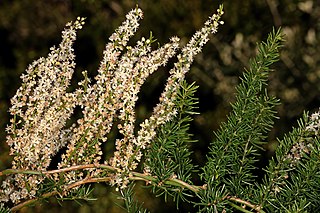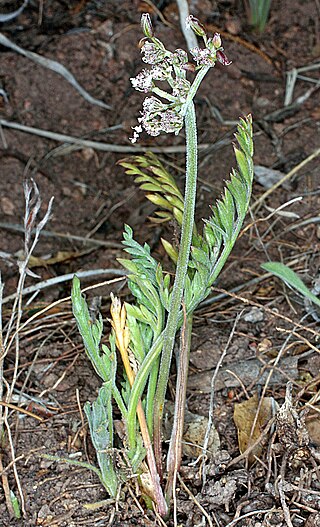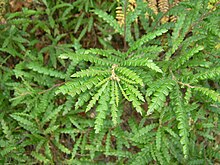
Chives, scientific name Allium schoenoprasum, is a species of flowering plant in the family Amaryllidaceae that produces edible leaves and flowers. Their close relatives include the common onions, garlic, shallot, leek, scallion, and Chinese onion.

The Fagales are an order of flowering plants, including some of the best-known trees. The order name is derived from genus Fagus, beeches. They belong among the rosid group of dicotyledons. The families and genera currently included are as follows:

Rhamnus is a genus of about 140 accepted species of shrubs or small trees, commonly known as buckthorns, in the family Rhamnaceae. Its species range from 1 to 10 m tall and are native mainly in east Asia and North America, but found throughout the temperate and subtropical Northern Hemisphere, and also more locally in the subtropical Southern Hemisphere in parts of Africa and South America. One species, the common buckthorn, is able to flourish as an invasive plant in parts of Canada and the U.S., where it has become naturalized.

Dysphania ambrosioides, formerly Chenopodium ambrosioides, known as Jesuit's tea, Mexican-tea, payqu(paico), epazote, mastruz, or herba sanctæ Mariæ, is an annual or short-lived perennial herb native to Central America, South America, and southern Mexico.

Myrica is a genus of about 35–50 species of small trees and shrubs in the family Myricaceae, order Fagales. The genus has a wide distribution, including Africa, Asia, Europe, North America, and South America, and missing only from Antarctica and Oceania. Some botanists split the genus into two genera on the basis of the catkin and fruit structure, restricting Myrica to a few species, and treating the others in Morella.

Myricaceae is a small family of dicotyledonous shrubs and small trees in the order Fagales with its type genus Myrica, the sweet gales. There are three genera in the family, although some botanists separate many species from Myrica into a fourth genus Morella. About 55 species are usually accepted in Myrica, one in Canacomyrica, and one in Comptonia.

Comptonia is a genus of flowering plants in the family Myricaceae, native to parts of eastern North America. It has one extant (living) species, sweet fern, Comptonia peregrina, and a number of extinct species.

Myrica rubra, also called yangmei, yamamomo, Chinese bayberry, red bayberry, yumberry, waxberry, or Chinese strawberry is a subtropical tree grown for its fruit.

Claytosmunda is a genus of fern. It has only one extant species, Claytosmunda claytoniana, the interrupted fern, native to Eastern Asia, Eastern United States, and Eastern Canada.

Asparagus aethiopicus, Sprenger's asparagus, is a plant native to the Cape Provinces and the Northern Provinces of South Africa. Often used as an ornamental plant, it is considered an invasive weed in many locations. Asparagus fern, asparagus grass and foxtail fern are common names; however, it is unrelated to true ferns. A. aethiopicus has been confused with A. densiflorus, now regarded as a separate species, so that information about A. aethiopicus will often be found under the name A. densiflorus.

Asplenium rhizophyllum, the (American) walking fern, is a frequently-occurring fern native to North America. It is a close relative of Asplenium ruprechtii which is found in East Asia and also goes by the common name of "walking fern".

Ionactis linariifolia also known as the flax-leaf ankle-aster, flaxleaf whitetop or simply aster is a North American species of plants in the family Asteraceae.
Cheiroglossa palmata, synonyms Ophioderma palmatum and Ophioglossum palmatum, variously known as hand fern, dwarf staghorn, or hand tongue, is an epiphytic or terrestrial fern. As an epiphyte it grows in old leaf bases of the cabbage palmetto.
Acleris kearfottana is a species of moth of the family Tortricidae. It is found in North America, where it has been recorded from Maine, Ontario, Pennsylvania, Quebec and West Virginia.
This fossil flora in Turkey stems from at least six Pliocene deposits in Güvem and Beşkonak villages, 80 kilometres (50 mi) north of Ankara, 22 kilometres (14 mi) north of Kızılcahamam and 125 kilometres (78 mi) south of the Black Sea coast. They are 1,000 metres (3,300 ft) to 1,500 metres (4,900 ft) above sea level, extending 15 kilometres (9.3 mi) north-south and 7 kilometres (4.3 mi) east-west. Between six and seven million years ago, a fresh water lake existed there in a forested area with mostly broad leaved deciduous tree species, dominated by sequoia and oak.

Oxypolis is a small genus of North American flowering plants in the carrot family known as cowbane, water dropwort, dropwort, hog-fennel, and pig-potato. As of 2020, Kew's Plants of the World Online accepts four species in the genus Oxypolis:

Comptonia columbiana is an extinct species of sweet fern in the flowering plant family Myricaceae. The species is known from fossil leaves found in the early Eocene deposits of central to southern British Columbia, Canada, plus northern Washington state, United States, and, tentatively, the late Eocene of Southern Idaho and Earliest Oligocene of Oregon, United States.

Lomatium orientale, commonly known as salt-and-pepper, eastern cous, eastern desert-parsley, eastern lomatium, white-flowered desert-parsley, oriental desert parsley or Northern Idaho biscuitroot, is a small spring blooming ephemeral plant. It grows in open habitats from the plains to foothills in western North America. It is known as one of the earliest blooming native flowers in its habitat. The species name, "orientale", is botanical Latin meaning "eastern".

Aspilanta argentifera is a species of moth in the family Heliozelidae, first described by Annette Frances Braun in 1927. It is found in eastern North America. The larvae are leaf miners that feed on several species of plant in the family Myricaceae.

















